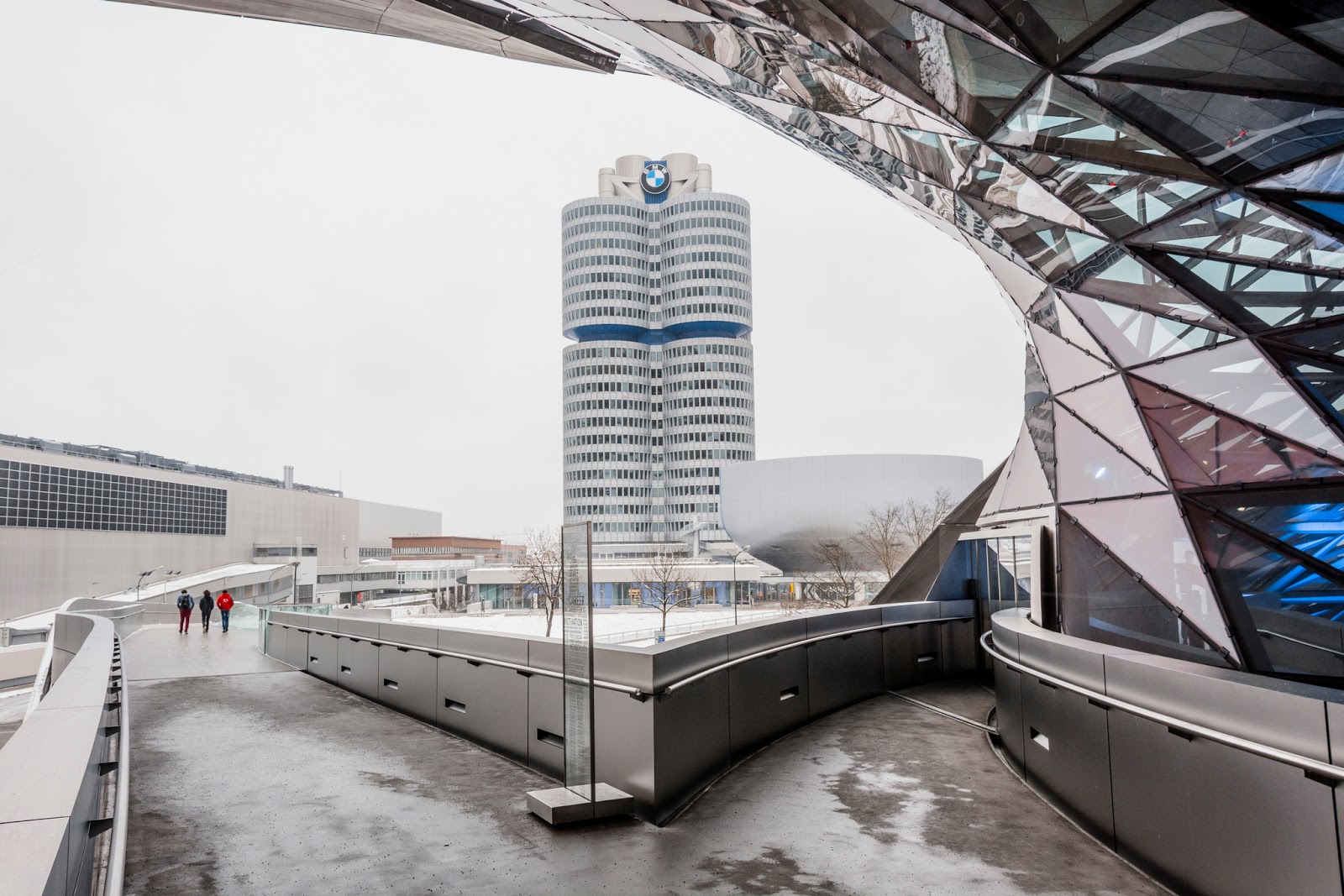 |
| I specifically made sure that I was in a good photo-taking spot at dusk. I definitely succeeded! More photos from this vantage point below |
 |
| My wintry day started outside of the city center. Here, Munich's TV Tower |
 |
| The Olympic Stadium for the 1972 Summer Games |
 |
| Although I'm no big car fan, the free admission was enough to draw me in. I left wanting a BMW. I'd even settle for this Rolls Royce |
 |
| How much do you think this futuristic i8 costs? Answer: 137,530 Euros! |
 |
| Loving the architecture |
 |
| The cylindrical building is BMW's headquarters |
 |
| Sweet, more cool architecture. This part of the BMW World is called "The Cone" |
 |
| Probably the only time I'll be in the driver's seat of a BMW... until I became rich and famous, at least |
 |
| Back to the city center! The Feldherrnhalle on Odeonsplatz, built in the 1840s, honors Bavarian generals and is modeled after a famous loggia in Florence |
 |
| The Hofgarten, behind the Residenz Palace |
 |
| The Grotto Courtyard was built in the late 1500s and exquisitely decorated with colorful shells and crystals. This fountain once spurted red wine |
 |
| The room was meant to demonstrate man's ability to control nature. After it was destroyed in WWII, Bavarians donated shells to help with the reconstruction |
 |
| Small paintings in the room's arches show 120 Bavarian villages as they looked in 1550. In that oval is Munich's painting |
 |
| Here you can see how it was later converted into a banquet hall |
 |
| Lots of statues line the wall, some dating back to Roman times |
 |
| The Black Hall, built in 1590. Check out the painting on the ceiling that gives the illusion of height |
 |
| The Audience Chamber: In this room, the ruling Elector received envoys and diplomats |
 |
| The Elector's bedroom. The original wall decorations were destroyed in WWII, but the silk covering still dates to the late 1700s |
 |
| This place is huge. One of a number of courtyards |
 |
| This room was built in 1615 and was originally meant for guests. The tapestries also date back to the 17th century |
 |
| A look at the Room of Judgement's decorative ceiling, adorned with a painting that displays an allegory of selection and judgement |
 |
 |
| The Emperor's Hall, built between 1612 and 1616 |
 |
| And here, a mummified hand. This is the third mummified hand I have seen in the last 4 months. See another here! You know you want to... |
 |
| The Ornate Chapel was built in 1607 and, naturally, destroyed in WWII before being rebuilt. On the wall are more relics |
 |
| A better look at the gold leaf and mini dome |
 |
| The Green Gallery, built in 1733 |
 |
| Now that's a family tree! The Wittelsbachs decided oh-so-modestly to have Hercules pictured at the bottom, planting their tree |
 |
| Cool! |
 |
| Leaving the Residenz behind, I headed into the nearby Baroque Theatinerkirche, built in 1662 |
 |
| The gardens are huge and made for a fun, wintry walk |
 |
| It was super snowy. I had never really been in that much continuous heavy snow before |
 |
| And now back to the pedestrian zone in the city center. This city gate, the Karlstor, was first built in the 1300s and repeatedly rebuilt thereafter |
 |
| The Bürgersaalkirche, built in the early 18th century |
 |
| Bürgersaalkirche |
 |
| I headed next to St. Michael's Church to get this daytime picture of its interior. It was built in the late 1500s by Jesuits determined to counter the Reformation |
 |
| Inside Munich's famous cathedral, the Frauenkirche. Built in the late 1400s, it also houses this grave of Ludwig the Bavarian, a Wittelsbach King who died in 1347 |
 |
| You can see the Frauenkirche's famous domes in my last post as well as below |
 |
| Next up - St. Peter's Church, the oldest church in town (it dates back to the 11th century). That's Peter crucified upside-down on the ceiling |
 |
| Marienplatz and Munich's New Town Hall (built 1867-1909) |
 |
| Frauenkirche in the background, on the left. My favorite shot of the day! |
 |
| The Old Town Hall on the right |
 |
| The Hotel Bayerischer Hof is the city's most luxurious, and often hosted VIPs like Michael Jackson |
 |
| One of the many shopping passageways that wind through Munich's Old Town |
 |
| Another look at the Max-Joseph Platz and the statue of Bavarian King Max Joseph. One wall of the enormous Residenz looms behind his statue |
 |
| Another look at the National Theater (opened in 1818) |
 |
| This memorial commemorates victims of Nazism. Himmler's Gestapo headquarters were once here |
That was more than enough sightseeing that day, even for me and my usually inexhaustible energy reserves. I saw everything important in Munich and got plenty of great pictures, though, so that's what counts. It has also made for my longest and most informative blog post to date! I feel like I have written almost as much about Munich as Berlin.
That night, I had to rest up for my early morning trip to one of Germany's most famous sights - Neuschwanstein Castle! Coming up next.
































